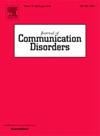Speech-language pathologists' views on visual discourse elicitation materials for cognitive communication disorder after TBI: An exploratory study
IF 2.1
3区 医学
Q2 AUDIOLOGY & SPEECH-LANGUAGE PATHOLOGY
引用次数: 0
Abstract
Background
Spoken discourse is elicited as part of speech-language pathology (SLP) practice after traumatic brain injury (TBI). Research literature reports on a range of monologic tasks for eliciting discourse samples, including different visual stimuli. The preferences of SLPs for these materials has not previously been investigated.
Aims
To explore the practice and views of SLPs on available visual discourse elicitation stimuli, specifically the clinical utility and acceptability of these tasks, and alignment with materials reported in research studies. We also sought SLPs’ perspectives on future discourse elicitation task development.
Methods & Procedures
We conducted a survey of Australian SLPs working with adults with cognitive-communication disorder post TBI. SLPs were asked about their use of and preferences around visual imagery, client engagement with visuals, and their suggestions for future stimuli development. Survey responses were analysed using descriptive statistics, and free text responses provided qualitative insights.
Outcomes & Results
Responses from 17 SLPs were included in the study. SLPs reported The Cookie Theft picture as the most frequently used visual stimulus. Reasons for use included familiarity with the task, ability to generate sample of sufficient length and complexity, and its accessibility. There were no strong preferences for any visual materials reported in this survey; however, overall, participants reported finding the existing visual materials to be unsatisfactory. Factors affecting choice of visual stimuli included the client’s visual abilities, interests, age-group, and severity of injury.
Conclusion & Implications
This exploratory study provided insight into SLPs' views on visual elicitation stimuli for discourse post-TBI, a largely unexamined area. The current findings contribute to limited knowledge of stakeholder views on elicitation tasks and will inform future research on discourse resource development after TBI.
语言病理学家对脑外伤后认知沟通障碍视觉话语启发材料的看法:一项探索性研究
言语话语是创伤性脑损伤(TBI)后言语语言病理学(SLP)实践的一部分。研究文献报道了引出话语样本的一系列单一任务,包括不同的视觉刺激。slp对这些材料的偏好以前没有研究过。目的探讨slp在可用视觉话语诱导刺激方面的实践和观点,特别是这些任务的临床实用性和可接受性,并与研究报告的材料相一致。我们还寻求了slp对未来话语引出任务发展的看法。方法,我们对澳大利亚的slp进行了一项调查,他们与创伤后认知沟通障碍的成年人一起工作。slp被问及他们对视觉图像的使用和偏好,客户对视觉图像的参与,以及他们对未来刺激发展的建议。使用描述性统计分析调查回复,而自由文本回复提供定性见解。结果,结果17名slp的反馈被纳入研究。slp报告说,“偷饼干”图片是最常用的视觉刺激。使用的原因包括熟悉任务,能够生成足够长度和复杂性的样本,以及它的可访问性。本次调查中没有对任何视觉材料的强烈偏好;然而,总体而言,参与者报告发现现有的视觉材料令人不满意。影响视觉刺激选择的因素包括病人的视觉能力、兴趣、年龄组和损伤的严重程度。结论,本探索性研究提供了slp对脑外伤后话语的视觉诱导刺激的看法,这是一个很大程度上未被研究的领域。目前的研究结果有助于了解利益相关者对诱导任务的看法,并将为未来的TBI后话语资源开发研究提供信息。
本文章由计算机程序翻译,如有差异,请以英文原文为准。
求助全文
约1分钟内获得全文
求助全文
来源期刊

Journal of Communication Disorders
AUDIOLOGY & SPEECH-LANGUAGE PATHOLOGY-REHABILITATION
CiteScore
3.30
自引率
5.90%
发文量
71
审稿时长
>12 weeks
期刊介绍:
The Journal of Communication Disorders publishes original articles on topics related to disorders of speech, language and hearing. Authors are encouraged to submit reports of experimental or descriptive investigations (research articles), review articles, tutorials or discussion papers, or letters to the editor ("short communications"). Please note that we do not accept case studies unless they conform to the principles of single-subject experimental design. Special issues are published periodically on timely and clinically relevant topics.
 求助内容:
求助内容: 应助结果提醒方式:
应助结果提醒方式:


